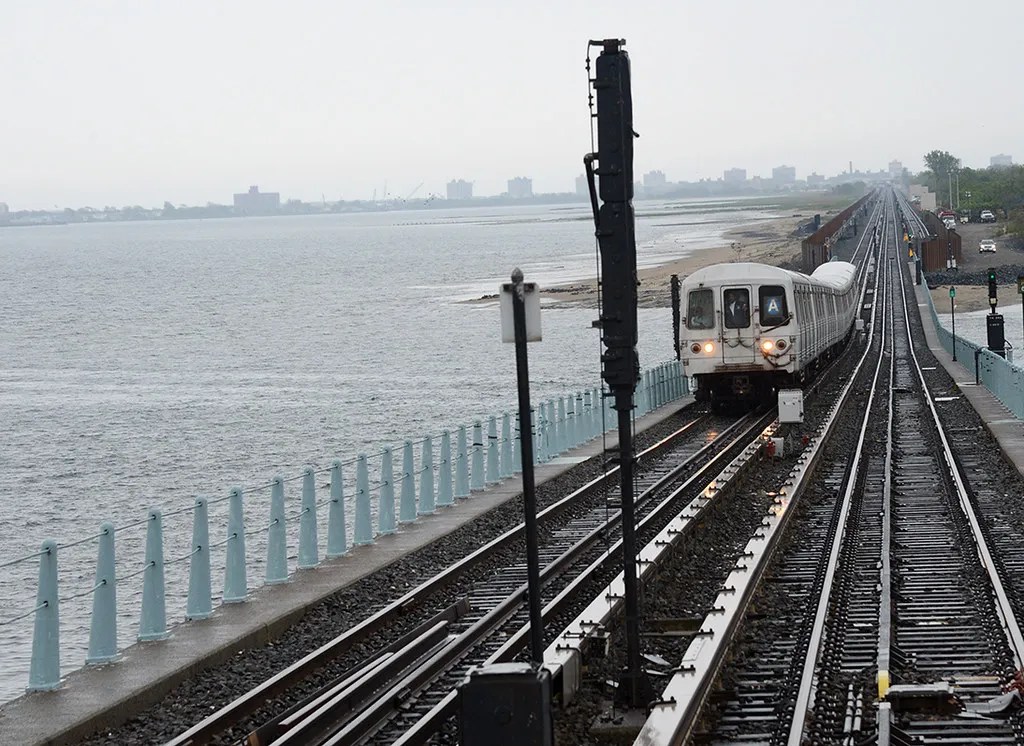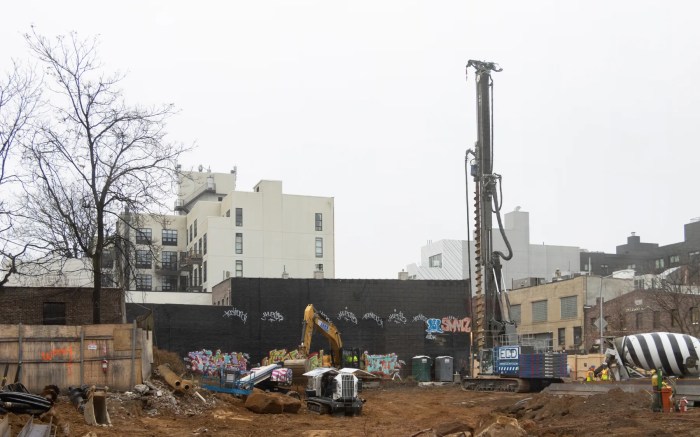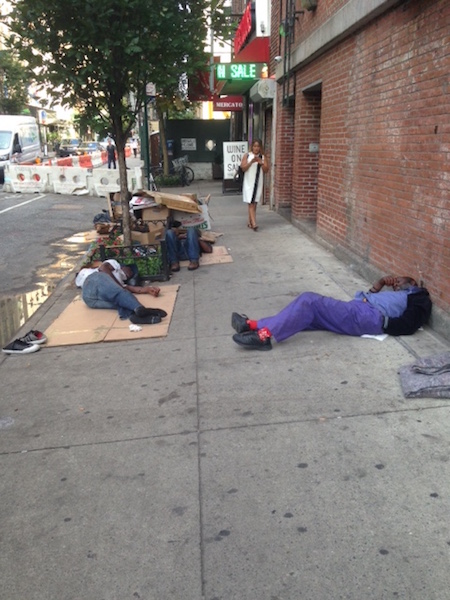
BY JOHN A. MUDD (President, Midtown South Community Council) | There is no avoiding them. Whether you’re bustling through the city or enjoying a leisurely Sunday, you are bound to step over one. You could simply shrug them off. You could eek out a pitiful sigh and turn away, uncomfortable with their discomfort. You could get offended by their odor and feel trespassed against by their pleas.
What if we took away “them” and put a name to a face? Imagine this person as a brother, a sister, or even yourself. Impossible? Never wanted to throw in the towel or think of yourself hanging on the fringe of society?
How about you give the next homeless person you see squatting on the sidewalk a story.
How long have they been on the streets? How did they get there? Are they addicted? What is their poison: alcohol, prescription meds, drugs? Are they depressed, schizophrenic? Did they have too many hard knocks or just one powerful sucker punch that put them down for the count? Now, is it harder to be egregiously affected or easier to empathize? I wrestle less with this dichotomy; even as I watch them sit in their chronic state, unbathed and stewing in the worst of odors. Empathy has won over annoyance.
Living in the tourist-saturated midtown of Manhattan for over 30 years, the homeless cannot be ignored — you see them often enough, and they find their place into your subconscious. I have had the luxury of knowing some of their real stories, rather than the imagined ones. While walking past a camp under a scaffold stretching the length of a 40-foot construction site everyday, I became privy to the boasts, plans, and world views of some of its inhabitants: Paul Bright, Donald Cook, Gerard, Chris, Michelle, Mr. Y, Mr. X, and others. I’ve seen them during alcohol-fueled belligerent tirades. I’ve seen them literally air their dirty laundry using the metal crossbars that anchor the scaffold together as a clothesline. I’ve seen their collection of treasured items on full display under the distressed tree that sprouts through the scaffold’s roof.
I naturally thought the homeless problem was a social one. The sight of human vulnerability, loneliness, and dispensability begs the question, “How did they get here?” Seeing the victims of homelessness bedded down on subway floors, slouched uncomfortably on benches, or encamped on sidewalks urges me to wonder why we are not doing more to help them. My job as president of the Midtown South Community Council (MSCC), a not-for-profit organization, tasks me with searching for answers.
“Ignoring” was not an option each day I walked along W. 38th St. through the encampment of sleeping bodies beneath jackets, thin sheets, and battered woolen covers. I had no intention of looking away. It was my block they decided to camp on; I needed to get involved. Although it took me several weeks to cut through the air of intimidation and begin my four-month-long conversation, it led me to an understanding of their lives and the eventual disbanding of the encampment.
I’ve been asked how I was so successful in disbanding the encampment. What urged me to action is a better question: I saw their faces, knew their names (or the names they gave me), and listened to their stories. Then there were those festering images of bugs and rats visiting their sleeping bodies, and the harsh rains gripping their tired old bones of those who yet to find their purpose. Compassion was easy when relating to them as fellow human beings. Empathy kept me persisting, meddling, and playing detective. More importantly, I wasn’t alone. I had plenty of support. It took a small platoon of homeless services (city, nonprofit, and faith-based organizations), media, and volunteers, who reached out, advised, offered resources, and more. And there was Mother Nature. When she swept in with some cold ferociousness hinting at harsher days to come, my remaining friends began to bend toward accepting help.
Of course there were hurdles. Finding services they would accept required trust. I needed to show that I was sincere, that it was going to be different with me, that I had something new to offer. They had already been questioned, put through various databases, and sent to shelters where they didn’t want to be. Better than no shelter at all? Not if they’d rather brave the harsh outdoors. They’d been there, done that, and had resigned themselves to the thought that this was all the world had to offer. What they didn’t know was they were floating in just a small part of a wide world of solutions.
Even still, they could not see the possibilities beyond survival and their current limited circumstances. When I asked Cassandra and Chris, a couple from the encampment, if they had dreams, if they could have whatever they wanted, anything at all, what would they be doing now? Cassandra, with earnest contemplation answered, “A minimum wage job.” Chris, with proud ambition said, “I have this idea for a T-shirt.” I encouraged them to broaden their scope of possibility. I got them interested and it gave me some credibility.
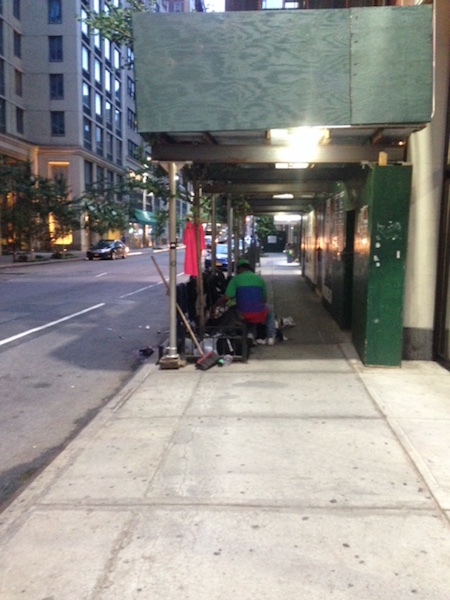
Now progress was paramount. They needed opportunities, extraordinary care, and individual attention to their particular needs. Finding services to match each case required research and networking. There was no one-size-fits-all solution. The various service providers — the city, not-for-profit groups, and faith-based homeless outreach services — had rules and requirements, some more stringent than others. Were they elderly? A veteran? An alcoholic? Were they having a gender crisis? Were they mentally challenged or depressed? Were they a transient or a victim of happenstance? How long have they been on the streets? Were they chronically homeless?
I did the best I could to source a fix for their needs in the time that I had. Besides contacting city, not-for-profit, and church-based services, I had the support of Inspector Russel J. Green of the NYPD’s Midtown South Precinct. Our network (in some cases) was able to confirm identities and clarify stories. Our diverse group was able to make more resources available, but more was still needed. We worked diligently to help those individuals find options outside their circumstances.
Initially, the dynamics of the encampment escaped the naked eye. It continually morphed as various tenants came and went. Some were just passing through, while others were there for trade. Skirting the lines of homeless to sell drugs and bodies were easy reasoning for disbanding the camp, but in that you had to wonder where the dealers, users, prostitutes, and pimps might take their business. It was not our desire to move Paul and the others to another part of the city. We wanted to help resolve their issues and try and transition them to a healthier lifestyle. We worked to pull Michelle away from her pimp and our presence hampered drug sales. We focused on the encampment’s anchor, and watched for anyone wavering from their commitment to continue their camping adventure.
As October 2016 approached, Mother Nature pitched in, the population thinned, and so did our patience. A date of action was set. We made regular visits to inform the group that we would be removing any items left on the sidewalk come the following Tuesday. The operation went well. With three volunteers to remove the collected items, outreach services to provide assistance to the remaining individuals, Midtown Precinct officers to tamp down any conflicts, and the sanitation department to pick up the considerable garbage, we made the block a happier place and we like to think we were able to help a few homeless people in the process.
The homeless condition begs for a cure. New York City, with an approximate 60,000 homeless, still leads our nation’s homeless population indices, with California a distant second. The housing, shelters, and day centers are near or at capacity. The badly managed and remote shelters cause many homeless to prefer the streets. Day spaces are fewer. We are in a crisis; before and through the 2016 homeless boom, funds were held up by political wrangling. Someone wanted something in return; a mix of developers and politicians were motivated less by the immediate needs of the homeless.
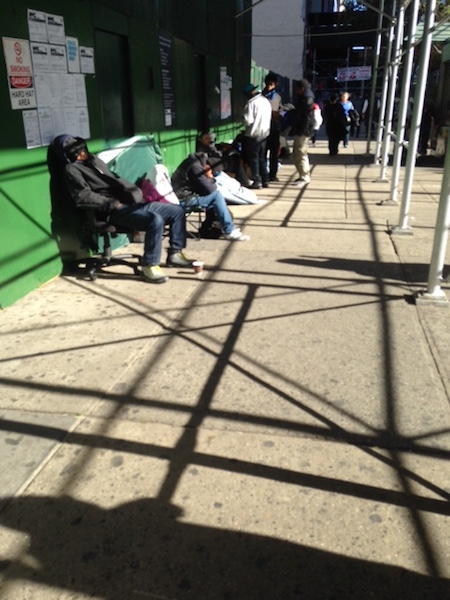
While the squabbling for self-interest is leaving our brothers and sisters on pitted sidewalks, progressive waves are eroding ideas of old. “Social” and “restorative” justice are taking root. Inequality and its long-term impact are being understood. People are leaning towards the welfare of others. But still there is work to do. There still exists an unwillingness to accept change or impinge on a system that puts wealth, individualism, and success in the same sentence. This puts us at a pivotal point; a time for change. The answers are with the new wave of thinkers and doers, who are sifting through the subterfuges of life, throwing off prejudices, and questioning those who would strangle progress and defy logic to pursue selfish needs to the detriment of others.
Our current administration knew better than to arrest homelessness away. Infringing upon their rights was not an option. Our societal problem can’t be ignored; shooing the homeless away, disregarding their civil liberties, and shuffling them elsewhere is not the solution. This administration took a more mature and compassionate approach to the problem only to be criticized. In the short-term it didn’t pay dividends, but the long-term will yield more than enough wealth.
The new wave of political leaders are joining the progressive line for the prosperity, health, and well-being of others. Assemblymember, Andrew Hevesi (D-Queens) has been pushing to swap shelters for subsidized housing. Not-For-Profits (Breaking Ground, Coalition for the Homeless, Housing Works, Urban Pathways) with their housing first programs pay immeasurable dividends in rebuilding the human spirit. Marc Greenberg, Executive Director of Interfaith on Homelessness and Housing, tirelessly lobbied for affordable housing and supportive housing. Faith-based and nonprofit organizations are sharing ideas and working together to create more housing opportunities. Innovative companies like Local Initiative Support Corporation (LISC) are finding higher dividends in the development of communities.
I, along with my network, pitched in to meet a growing crisis on my block. That block must extend throughout midtown and beyond, not only for our comfort, but to cure the illness of the human condition that would lead men and women to live on the streets. How morally bankrupt are we if we leave our brothers and sisters to that fate?
For more information about the Midtown South Community Council, visit midtownsouthcc.org.

















